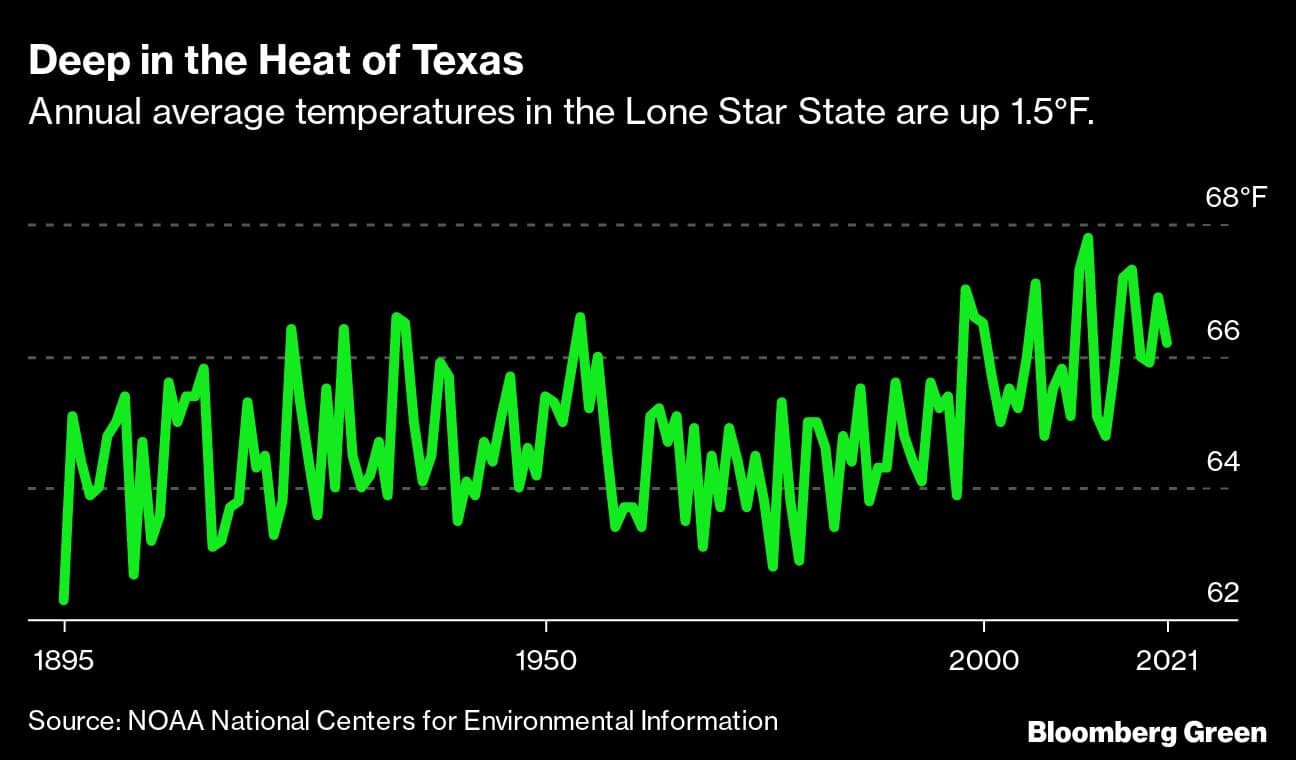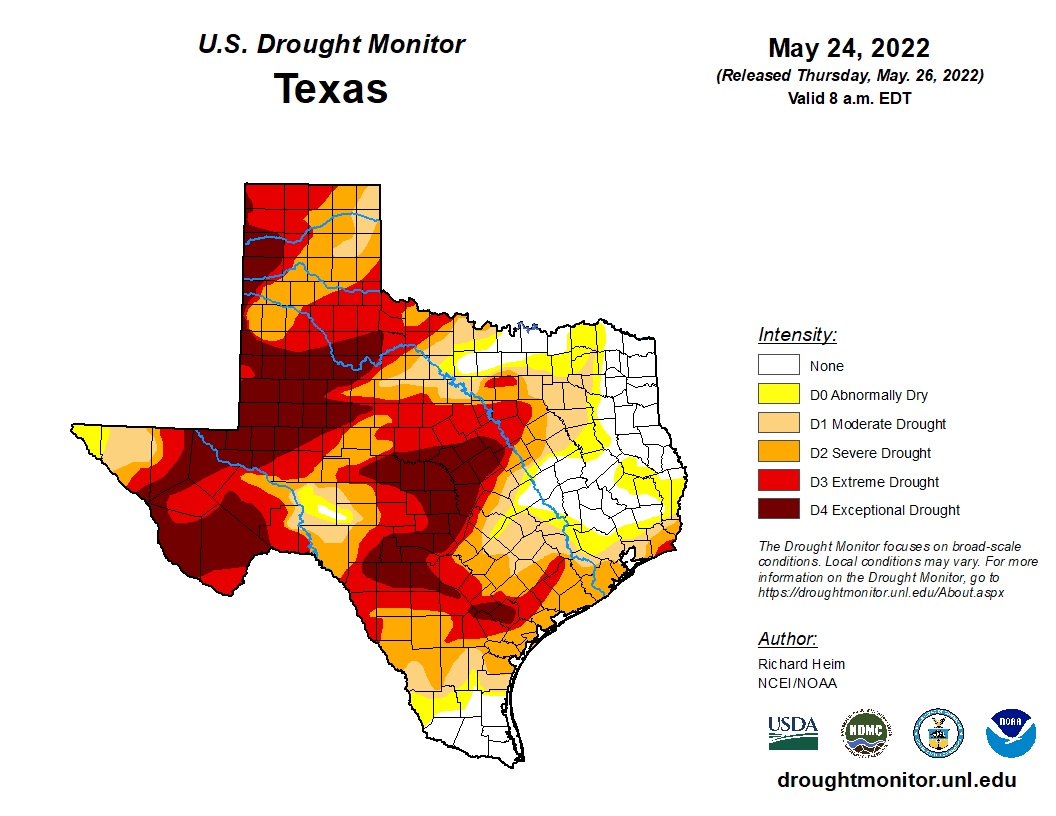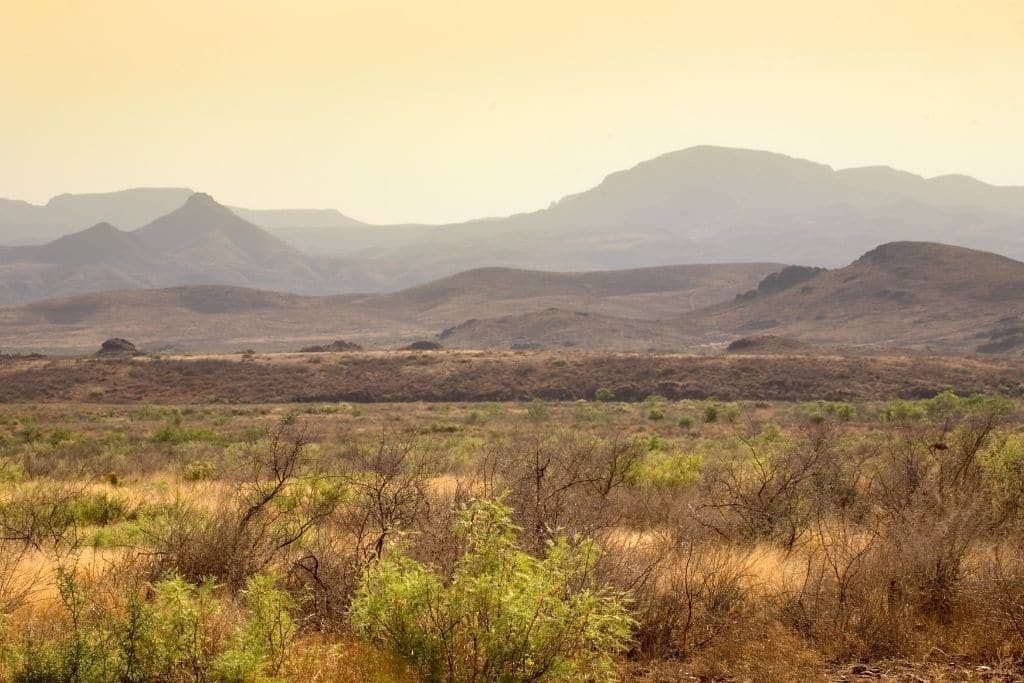Climate change is having a huge impact on Texas. The second-largest US state located in the south-central part of the country – is consistently ranked among the top 10 states most affected by extreme weather events, such as drought, extreme heat, and wildfires. We take a look at Texas’ main environmental issues and what the state is doing about it.
—
4 Environmental Issues in Texas
1. Heatwaves
As a 2021 climate report pointed out, record-breaking heatwaves that hit Texas repeatedly in recent decades will become a regular occurrence because of climate change, and the future of the state depends almost exclusively on climate mitigation and adaptation.
Within the past century, most of Texas has warmed at an average of almost 1.5F (0.8C), and summers are getting longer and hotter. The most recent and still ongoing heatwave that hit central US and Texas in late April 2022 has led to three-digit temperatures in the state’s southern and mid-western band for several consecutive days and is spreading north through the Great Plains. According to the aforementioned report, the number of triple-digit days in a year will double by 2036 compared to the past 20 years and temperatures will be a full three degrees warmer than they were from 1950 to 1999.

Texas Temperature Increase, 1895-2021. Image: Bloomberg Green.
The heatwave also sparked record demand for air conditioning and electricity. Nearly 45% of it is met by renewable sources, with both solar and wind power generations rising considerably. Historically, the state usually experiences high temperatures during the summer months, however, heatwaves have arrived earlier in recent years as a result of the changing climate.
You might also like: Climate Change Made Southern US Heatwave Five Times More Likely, Scientists Find
2. Droughts
The intense heatwaves that Texas is experiencing enhance droughts. The Lone Star state is known for its arid climate and while droughts are a natural occurrence here, climate change and rising global temperatures have made them much more severe in recent decades, altering rainfall patterns and drying moisture in the soil at faster rates. For this reason, Texas is classified as the state most at risk of widespread drought, with experts predicting that by 2050 it will see an increase in the severity of such events of nearly 75%.
Overall, experts estimate that in the coming years, average rainfall is likely to decrease – especially during winter, spring, and summer and in 70 years’ time, the longest period without rain each year is likely to be at least three days longer than it is today. This will contribute to increased evaporation and subsequent reduction in water content in rivers and streams as well as insufficient water to irrigate crops or even drinkable water to satisfy the basic needs of Texas’ growing population.

Texas Drought Monitor, May 2022. Image: State Drought Monitor.
Water shortage in Texas is also a big issue from an economic point of view. The state is based on three, very thirsty sectors – fossil fuel generation, real estate development, and agriculture – with nearly 60% of Texas’ water resources used for crops. Each sector is heavily impacted every time droughts occur. The food industry is particularly vulnerable: as severe droughts damage crops and limit forage growth needed to raise cattle for beef, the state’s supply chain will be under immense pressure, likely leading to a spike in food prices.
3. Wildfires and Extreme Weather Events
Heatwaves and droughts are not the only issues Texas should be worried about. Hotter temperatures and drier conditions are driving up the risk of wildfires and intensifying weather events such as rainstorms and hurricanes.
Already in the spring of 2022, hundreds of wildfires have broken out amid an intense heatwave, leading to more than 200 counties being classified as ‘crop disaster areas’ – meaning that their crops are expected to either fail or be significantly smaller as a result of wildfires. Between January and May 2022, more than 400,000 acres have burned, seven times as many acres as the same period last year. Fears of water shortages have also prompted the Texas Commission on Environmental Quality to issue mandatory water use restrictions, as water levels in some reservoirs have fallen to less than 20% of capacity.
Currently, more than 70% of the state’s population, equivalent to nearly 18 million people, live in areas at elevated risk of wildfire. Texas – which currently has the second-highest wildfire risk in the US after California by 2050, is expected to become the state most threatened by such events as global warming worsens.
While climate change is often associated with rising temperatures, scientists suggest that the impact of global warming on the Arctic can cause southerly cold snaps like the ones that Texas repeatedly experienced in the last few years. The most recent one took place during the first months of 2021, when the state was hit by a blast of cold air coming out of Canada that caused breakdowns in water systems, overburdened the electrical grid, and triggered widespread power outages.
Global warming has also drastically intensified the impact of hurricanes. As temperatures rise, evaporation accelerates, so does the transfer of heat from oceans to the air. The heat and vapour that storms absorb when travelling across warm waters fuel winds and rainfall, causing increasingly severe floods. 2021 was an ‘above average’ and fourth-most costly Atlantic hurricane season on record, with 21 severe storms hitting Texas, seven of which became hurricanes, in addition to four other major hurricanes.
The worst event to hit Texas was Hurricane Harvey in 2017, which resulted in more than 100 fatalities, caused flood water contamination resulting from a chemical facility malfunction, and cost the state a staggering USD$125 billion in damage. New research suggests that the odds for slow-moving storms like Harvey happening more frequently during the Atlantic hurricane season are now higher than ever, as climate change is expected to intensify winds that steer hurricanes north over Texas in the final 25 years of the current century.
You might also like: The Worst States for Climate Change in the US in 2023
4. Sea Level Rise
One last major climate change-related environmental issue in Texas is above-average sea level rise. Between 1950 and today, sea levels already rose 18 inches (41 centimetres) and continue to rise at a faster rate of about one inch (2.5 centimetres) per year. This, coupled with coastal erosion, is putting the agglomeration around Texas’ most populous city, Houston, at risk of regular flooding in the coming decades. Slightly higher sea levels can make a big difference in extreme storm surge occurrence. A 1-in-100 year flooding event (an intensity that has a 1% chance of occurring in any given year) could become a 1-in-10 year event by 2050, making communities living near coasts much more vulnerable. Today, Texas has 127,000 people at risk of coastal flooding but by mid-century, an additional 117,000 people are projected to be at risk due to this phenomenon.
Is There A Way Out?
Texas weather is rapidly changing due to climate change, making living in the state harder and recovery from increasingly disruptive events much more expensive. Experts agree that preparation and resilience have to be on top of the agenda. Yet, the only long-term solution to extreme weather events is to tackle the root cause, climate change. Our planet has already warmed around 1.1C since pre-industrial times, and we are still on track to exceed 1.5C of warming within the next two decades. Unless the world at large drastically stops adding greenhouse gases to the atmosphere, record-high heatwaves and other extreme weather conditions will become even more frequent, threatening millions more lives around the world. The race is now on to drastically cut emissions and help people adapt to warming that is already locked in.
If you enjoyed reading about Texas’ environmental issues, make sure to check this out next: Top 6 Environmental Issues in the US in 2022


















